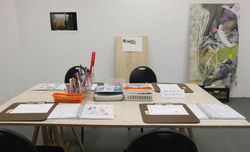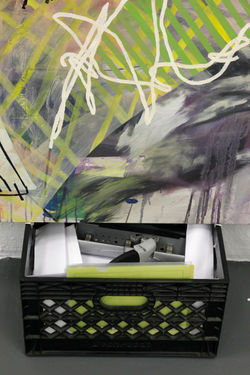 |  |
|---|---|
 |  |
 |  |
 |  |
 |  |
 |  |
 |  |
 |  |
 |  |
 |  |
 |  |
 |  |
 |  |
 |
Learning Art & Art Learning Society
Howard (7 years old student): I don’t get it!.... I don’t get it still!...
I still don’t get it!... It is not finish yet!
( ha-ha)
John Wu( art teacher): (ha-ha,) It is a piece of Don’t Get It.
A Dog Behinds The Gate
Dad’s Dog behinds the gate,
He is behind the gate always,
We always see him behinds the gate,
before we leave the house and when we get back.
Was the dog behinds the gate all the time?
???
...We love this dog behinds the gate.
Tammie Tsai’s Window Display Paintings
Tammie’s few paintings have been displayed in her windows and face the outside for years. This way of displaying her art probably began before we met. We attended a foundation painting class 11 years ago at Pasadena City College and that is how we know each other. This is how I became Tammie and her brother John’s art tutor. All of Tammie’s window paintings have been considered unfinished ones, bad paintings, or just as studies from foundation painting class. Tammie displays her “bad paintings” to keep strangers or thieves away from her house. Tammie thinks, “my displayed paintings will create a strong impression that we are poor artists and we don’t have any valuable things in our house, even the art that we produce are bad works. So please don’t bother us.” Do the paintings really work the way Tammie expects? It probably does not. Does Tammie really believe the paintings can protect them and her property in some ways? It probably she does, otherwise she wouldn’t do it.
John Tsai’s Still-life painting
I meet every other week with John and Tammie in their home. Recently, I began to do still-life study lessons with John, setting up a group of objects for him to draw and paint. The still objects are typically set up to create an overlapping relationship. John fits all the objects into a composition, even the image of the object can’t practically be cropped or shown in correct proportion. Everything exists in his vision; it is of that instant, and he supposes then that everything exists fully in the image he is making. He sees and interprets the set of objects in space as a whole;, and he thinks about and draws just one object at a time. Representing actual spacial relationships between the
objects in a flat image has been impossible for John Tsai to see and make sense of. It is this interpretation and way of seeing that makes John Tsai’s art so interesting to me. Is it possible for me to understand how he paints what he sees?
A leaf is green, in general, and when John looks at the green leaf in front of him, he selects a single green color that will suffice for representing all leaves no matter what variations of light or shadow is present. John understands that, in
reality, objects do have shadows, and paints the shadow for an orange and a vase becomes a realistic way to represent them. But he simply can’t observe how the shadow looks in relationship with any given objects, such as an orange in front of a partially obscured vase. It is difficult for him to see and represent these in a two dimensional
image. If I set up the still-life with a white color background, he won’t paint any background color. While it might seem obvious to see the surrounding reflected colors and shadows on the white background, it is not obvious for him. He paints what he knows, not what he sees. Or, no, he looks at what is in front of him, but perhaps what he sees is recalled from memory of what he is looking at. Or maybe not, it’s possible that he has tapped into a knowledge of what the objects are, but lacks the ability to see and represent the physical context between the objects. I don’t know. To find out how and why he does what he does—perhaps doesn’t really matter. After I leave their home, Tammie often corrects her brother’s works, and helps John “improve” his paintings. I can tell Tammie helped John on the table perspective in this painting; she has drawn in perspective lines over his marks. I suspect the biggest reason Tammie continues to hire me because I provide an
impression of the structure of a class. Otherwise, John won’t make anything. My formal Academy training was my qualification, even though I don’t teach drawing in that manner. The most important thing is that we have been close friends, and for years now. We help each other in many different ways in our lives.
Art becomes the way out of the ordinary.
There has been no art, it is only life.
The model of representation. The representation on top of representation.
I want to consider the subjectivity of an individual who makes creative things, displays them, writes about them, gives them meaning, photographs them as a form of publication, documents the process of the creation, sets up a condition where art may happen, and finds ways to articulate the everyday activity into “Art”: the birth of art after another birth of art and after another, and so on. It always represents the ordinary making or representing the representation. But what is art about, and what is the given of art?
The notion of Art builds into people’s lives deeply and widely. John Tsai and Tammie Tsai’s faith in their art and the function of art in their life triggered the beginning of this project. Both of them were born and grew up in Taiwan. Tammie moved to The U.S. to pursue her Master’s degree in Fashion Design. She has been taking art classes since her retirement 12 years ago. She believes academic art is the way to learn art and become an artist. John has had schizophrenia since his 20s, and has lived with his older sister, Tammie, for about 40 years in Los Angeles. To him, art making is therapeutic. Tammie and John have been very independent about everything in life, but now they are worried that no one will look after them. Tammie and John continually dedicate themselves to learning art, and Tammie believes art is the only way to give them a better life. Tammie has a passion for learning, and takes her study very seriously. To her, all information about art is fascinating, and there is always more and more to study.
Tammie has found different art tutors to give her brother art lessons. I am one of those tutors. John Tsai currently takes college art course thanks to Tammie’s encouragement. I don’t think John Tsai has enjoyed the activity of learning art and making art. To him, It is a duty to get the job done if someone gives him an assignment. There is a moment of release and joy if John Tsai has finished his assignment on schedule. Tammie believes art learning is the only way that can help John’s illness and so that he can build confidence in life. She has been trying to figure out a better way to live for John. Tammie has continuously pushed John to learn art in parallel with her art studies. I knew them for years but I never took seriously their art works and art practice. To me, their art has been outsider art no matter how hard they tried. Now I feel we have been collaborating on something for long time through the course of
learning art to think about what art is.
Gift
2012
56” x 72”, oil painting on canvas
#1
“The chicken toy was a gift for the dog, the dog was a gift for my Dad, the 56”x72” oil painting was a gift for my family.”
#2
“The chicken toy was a gift for the dog, the dog was a gift for my Dad, the 56”x72” oil painting was a gift for my family.”
Showing the 8.5" x 11" photo reproduction of the painting with its original painting’s info and description as a whole that hopefully provides a moment of visualizes the actual painting in viewers’ mind. This experience of seeing something absent is the visual art in mind.
#3
I am the only artist in my family. My parents always wanted me to make something beautiful, such as a painting of flowers, landscape, or realistic portrait. They wanted to use it for decoration and show off to their friends. Ultimately, I painted a large portrait of my Dad, his dog, and the dog’s chicken toy. The chicken toy was a gift for the dog, the dog was a gift for my dad, and the painting was a gift for my family. Then I made my art piece, an 8.5" x 11" photo reproduction of the painting, framed it with a traditional frame, and wrote three text come along with.